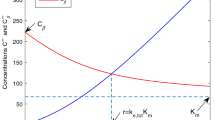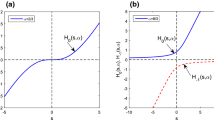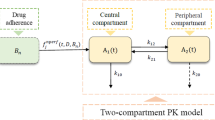Abstract
In drug therapy, effective dosage strategies are needed to maintain target drug effects. The relationship between drug dose and drug effect is often described by pharmacokinetic/pharmacodynamic (PK/PD) models where typically the PK model has a multicompartment form and the PD model is the sigmoidal Emax model. The parameters in the PK/PD model are generally unknown in the individual patient, although prior knowledge may be available and can be updated after measurements of drug effect are taken during the therapy. This fact, together with the complexity of the PK/PD model, makes the control problem complex. This paper investigates several control strategies in the framework of a three-compartment PK model plus an effect site with a PD model. Using computer simulations under different assumptions, we show that a MAP (maximum a posteriori) Bayesian type of strategy is effective, nevertheless in high-risk situations a stochastic control strategy hedging against estimation errors provides better performance at computational cost.
Similar content being viewed by others
References
M. Gibaldi and D. Perrier.Pharmacokinetics, Marcel Dekker, New York, 1982.
C. J. Hull, H. B., Van Beem, K. McLeod, A. Sibbald, and M. J. Watson. A pharmacodynamic model for pancuronium.Br. J. Anaesth. 50:1113–1123 (1978).
L. B. Sheiner, D. R. Stanski, S. Vozeh, R. D. Miller, and J. Ham. Simultaneous modelling of pharmacokinetics and pharmacodynamics: Application to d-tubocurarine.Clin. Pharmacol. Ther. 25:358–371 (1979).
S. L. Shafer and K. M. Gregg. Algorithms to rapidly achieve and maintain stable drug concentrations at the site of drug effect with a computer-controlled infusion pump.J. Pharmacokin. Biopharm. 20:147–169 (1992).
P. O. Maitre and D. R. Stanski. Bayesian forecasting improves the prediction of intraoperative plasma concentration of alfentanil.Anesthesiology,69:652–659 (1988).
L. B. Sheiner, S. Beal, B. Rosenberg, and V. V. Marathe. Forecasting individual pharmacokinetics.Clin. Pharmacol. Ther. 26:294–305 (1979).
S. Vozeh, M. Berger, M. Wenk, R. Ritz, and F. Follath. Rapid prediction of individual dosage requirements for lignocaine.Clin. Pharmacokin. 9:353–363 (1984).
S. Vozeh, R. Hillman, M. Wandell, T. Ludden and L. Sheiner. Computer-assisted drug assay interpretation based on Bayesian estimation of individual pharmacokinetics: Application to lidocaine.Ther. Drug Monit. 7:66–73 (1985).
S. Vozeh and C. Steiner. Estimates of the population pharmacokinetic parameters and performance of Bayesian feedback: A sensitivity analysis.J. Pharmacokin. Biopharm. 15:511–528 (1987).
D. P. Heyman and M. J. Sobel.Stochastic Models in Operations Research, McGraw-Hill, New York, 1984.
D. Z. D'Argenio and J. H. Rodman. Targeting the systemic exposure of teniposide in the population and the individual using a stochastic therapeutic objective.J. Pharmacokin. Biopharm. 21:223–251 (1993).
D. Z. D'Argenio and K. Park. Stochastic control of pharmacodynamic processes with application to terbutaline.Proceedings of the IFAC Symposium, Galveston, TX, 1994, pp. 246–247.
C. Hu, W. S. Lovejoy, and S. L. Shafer. Comparison of some suboptimal control policies in medical drug therapy.Operations Res.
P. O. Maitre, S. Vozeh, J. Heykants, D. A. Thomson, and D. R. Stanski. Population pharmacokinetics of alfentanil: The average dose-plasma concentration relationship and interindividual variability in patients.Anesthesiology 66:3–12 (1987).
H. Schwilden. A general method for calculating the dosage scheme in linear pharmacokinetics.Eur. J. Clin. Pharmacol. 20:379–383 (1981).
D. Z. D'Argenio and D. Katz. Application of stochastic control methods to the problem of individualising intravenous thephylline therapy.Biomed. Meas. Inform. Contr. 2(3) (1988).
C. Hu, W. S. Lovejoy, and S. L. Shafer. An efficient control strategy for dosage regimens.J. Pharmocokin. Biopharm. 22:73–94 (1994).
D. P. Bertsekas and S. E. Shreve.Stochastic Optimal Control: The Discrete Time Case, Academic Press, New York, 1978.
K. M. Van Hee,Bayesian control of Markov chains, Mathematical Centre Tract 95, Amsterdam, 1978.
W. S. Lovejoy. Suboptimal policies, with bounds, for parameter adaptive decision processes.Operations Res. 41:583–599 (1993).
R. W. Jelliffe and A. Schumitzky. Modeling, adaptive control, and optimal drug therapy.Med. Prog. Technol. 16:95–100 (1990).
P. E. Gill, W. Murray, and M. H. Wright.Practical Optimization, Academic Press, London, 1981.
S. E. Kern and D. R. Westenskow. Development of a closed loop system for neuromuscular blocking agents given in intensive care.Proceedings of the IFAC Symposium, Galveston, TX, 1994, pp. 172–173.
Author information
Authors and Affiliations
Additional information
Partially funded by Palo Alto Institute for Research and Education Inc., and the Veterans Administration Merit Review Program.
Rights and permissions
About this article
Cite this article
Hu, C., Lovejoy, W.S. & Shafer, S.L. Comparison of some control strategies for three-compartment PK/PD models. Journal of Pharmacokinetics and Biopharmaceutics 22, 525–550 (1994). https://doi.org/10.1007/BF02353793
Received:
Accepted:
Published:
Issue Date:
DOI: https://doi.org/10.1007/BF02353793




